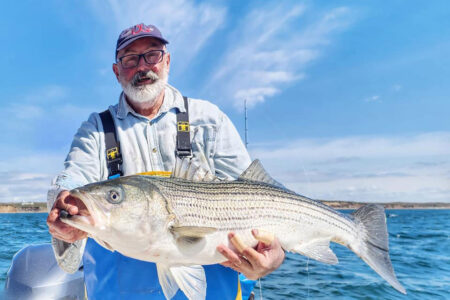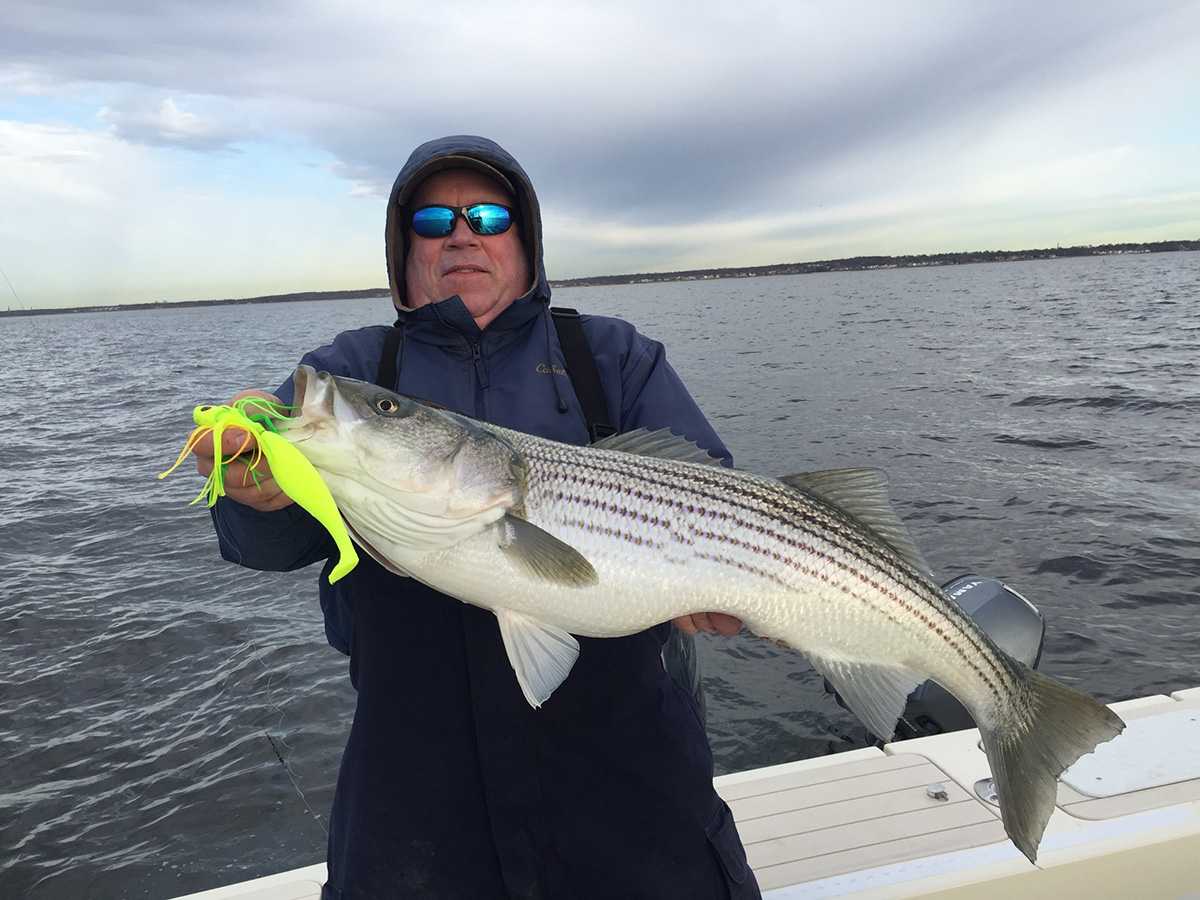
It’s just a simple addition to the tool box that doesn’t require major gear overhaul.
Trolling is a tried and true method of finding and raising some impressive striped bass; it’s also a method often utilized when fish are scattered and not concentrated in any specific area.
No doubt, trolling is a great way to search out your prey, and it works well when smaller fish are schooled up and you need to locate larger ones. Simply follow the tide away from the birds and schooled fish, and often you’ll find larger cows sitting back and picking off the freebies that the younger smaller fish let drift by as they chase spearing and bunker.
Historically, slow trolling eels, tubes, umbrella rigs, parachutes, plugs, poppers and spoons have been one of the “go to” methods in the Northeast with either downriggers or wire line employed to get lures down into the exact critical depth known as the strike zone.
Yet while Northeast fishermen were fine-tuning their own methods of getting lures into that strike zone, lower Mid-Atlantic anglers were experimenting with their own tactical approach to reaching those “rockfish” on the troll.
When dealing with depths anywhere from 20 to 75 feet while trolling at speeds of 3 to 5 knots, the traditional 8- to 10-pound downrigger balls really weren’t necessary; the theory was that downsizing weight into the 1- to 3-pound range would be more effective. So, tie it off to a three-way swivel and add a leader with your preferred lure and the MOJO was born. It was a great way to get your line into the zone without a downrigger or 300 feet of wire line, especially in sandy, barren, structure free areas where stripers were scattered and on the move.
Somewhere down the road the lead ball turned into a heavy lure; the only thing better than one hook in the strike zone is having two. Enamel paint and sometimes eyes were added to make it look realistic, and hooks were topped with nylon hair and sometimes pork rind was added to increase the action. Large swim shads replaced the pork rind, and the nylon hair was tied facing forward to add to the overall perceived size.
In recent years of course, the modern day mojo rig—made famous decades ago on the lower Mid-Atlantic grounds—has become a popular method of trolling stripers into the entire Northeast region.
Gear Up Troll
It’s probably not necessary to run out and buy all new gear. Start with what you may already have, add and change things up as you learn what you need. There are many rod options to choose from. Longer, stiffer rods with good tip action are your best choice. Lever drag high speed reels that you might have in your arsenal for chunking will be the perfect match. The classic Penn 113H and 114H (go to wireline reels) are also good choices.
The thin profile of braid makes it the optimal line choice for mojo rigging, with 60-pound test plenty. Tie the braid directly to the three way swivel, with 6 to 8 feet of 40- to 60-pound mono directly to the mojo weighted lure and then to the bottom of the swivel. Tie 10 to 16 feet of the same mono (Some anglers choose fluorocarbon.) to the remaining side eye of the swivel and add your lure of choice.
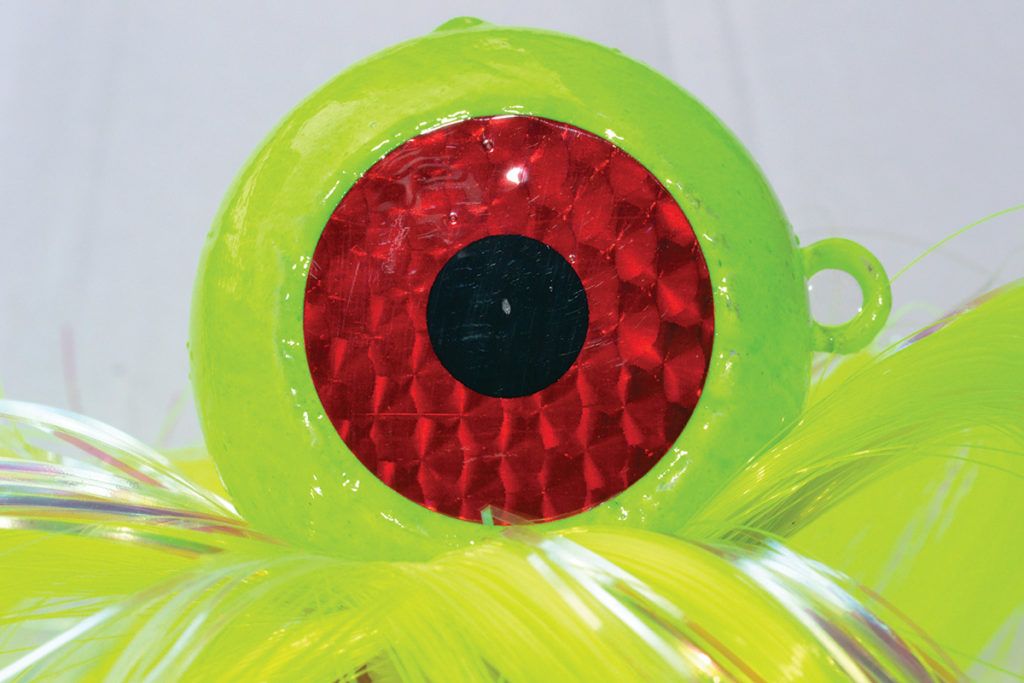
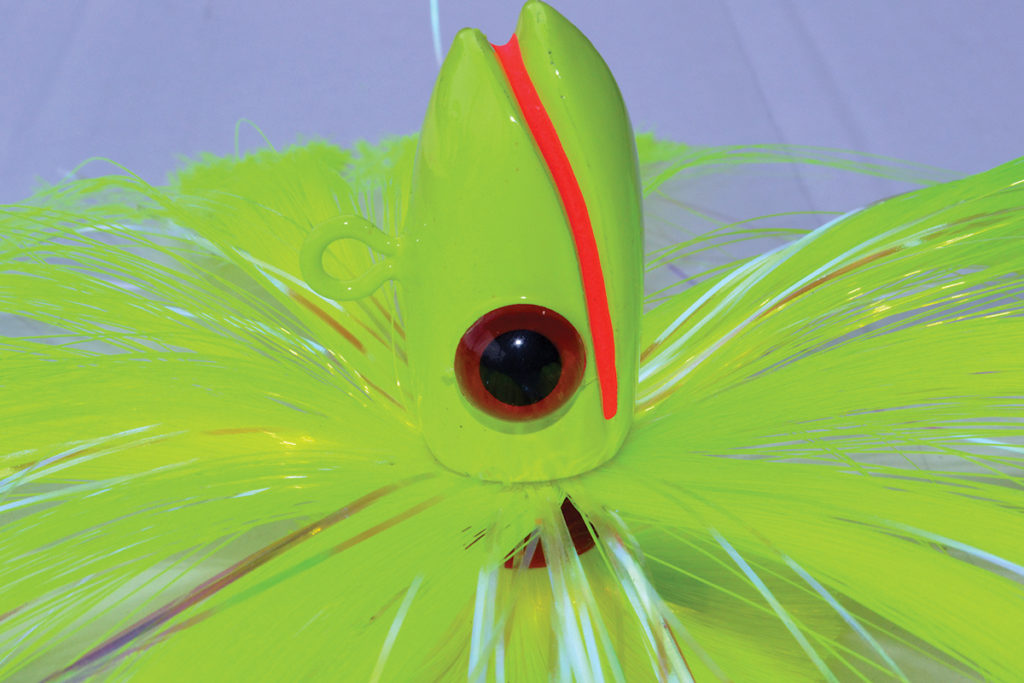
Of course, when reeling in a nice bass the classic mojo set up is not also conducive for the end game considering the swivel and the amount of leader deployed. I have seen plenty of pictures and videos of mate’s handlining fish while standing on outboard brackets and the like. Capt. Mike Farmer of Break Even Charters has advanced mojo trolling one step further to alleviate that issue. His new Nonpareil Fishing (www.nonpareilfishing.com) incorporates a tandem wind-on mojo leader. Hollow core braided line is configured into a “Y” with two legs of the “Y” having leader spliced into them, a loop on the third. You simply use a loop to loop connection to connect it your braid running line.
The wind-on concept takes the place of the three-way swivel and allows you to wind the leader onto the reel, eliminating the need to hand line the fish. Use split rings to attach barrel swivels directly to the lures or tie on snap swivels to make switching lures easy. This set up allows you to reel directly up to the weighted ball. If the fish is on the weight you simply swing it on board or net it (being mindful of the lure 8 feet or so behind it). If the fish is on the lure you reel the weight close to the tip and back up. The fish will be 6 to 8 feet off the tip and easily netted or swung aboard.
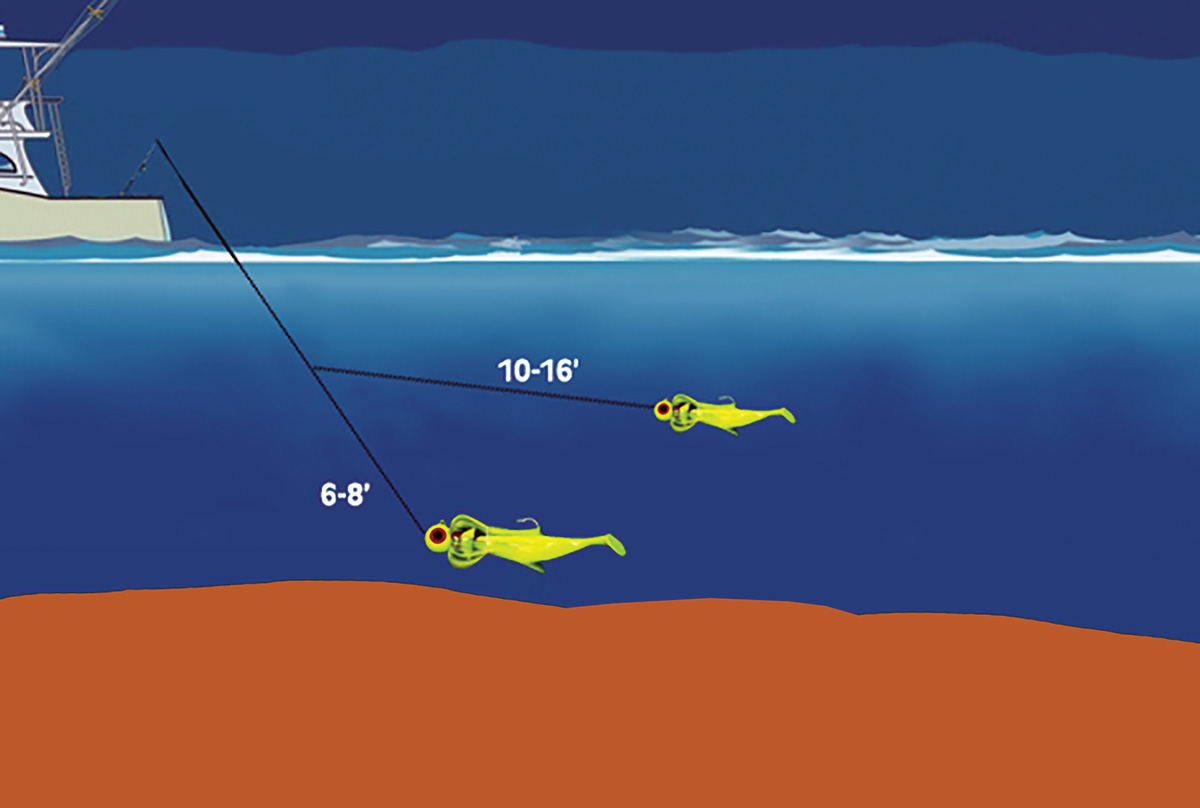
When all the pieces come together, and the fish are cooperative, two rigs and two fish at one time can lead to arm-weary action.
The Mojo Method
In terms of deploying your mojo set-up, the easiest method is to stop the boat and drop the top lure (on the longer leader) into the water. Letting out a few feet of line holding the large weighted lure in your hand. Thumbing the spool carefully drop the weighted lure into the water. Hold the weight 6 to 8 feet below the surface, let that leader stretch out in the current and carefully let line out until you feel the bottom. Lock up the reel into trolling position and with the rod securely in the proper rodholder put the boat in gear and achieve your desired trolling speed. The drag on the line will pull your weight off the bottom as you troll. Drop it back and kiss the bottom, lock it up again, and this should put you right off the bottom.
Note your depth; if you see it drop off you may need to let more line out. If you see the rod dig in and bounce you’re on the bottom. Crank up a little until it stops. If you’re trolling two or more rods use different size mojos. The slightly lighter one will require more line to stay in the same depth and will most likely track slightly higher. Staggering the lines will help prevent tangles as you maneuver the boat. Outrodders of course are a great way to get two lines off the same side. Place lighter mojos there, and add two heavier mojos in the corner rodholders. This will allow you to easily put a fifth rod down the middle (same weight as outside mojo, lighter than the corner rods).
When a fish hits don’t be in a rush to clear all the rods. Look for multiple hook ups. As you continue to troll the hooked fish should pull drag and start to plane itself up clearing the other lines. When it’s time to clear the rods, work them. As you reel in do it slowly and stop and drop back as you bring it in. Oftentimes you can entice a second hook up.
Mojo trolling is not the “be all end all,” it’s another tool in your striper box. The action of a spoon on 300 feet of wire has a different look than a small spoon on a mojo; whereas the action on wire is a slower sweeping action, the mojo with a shorter leader will be quicker and more sporadic. The same is true for parachute lures. The classic Montauk long sweep and drop back, on the other hand, will never be achieved on a mojo.
We all know fish are finicky and respond to different techniques on any given day. Arm yourself with as many tools as you can and don’t be afraid to experiment.
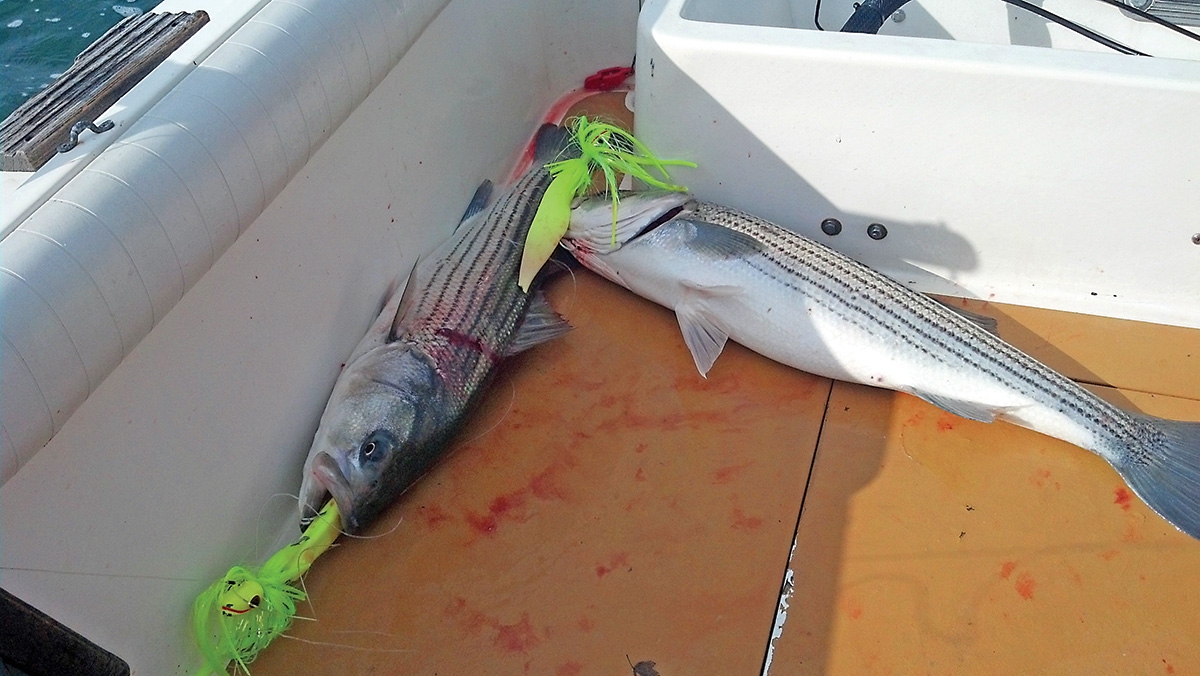
| MOJO MEDLEY – WEAPON SELECTION |
|---|
| North Carolina based Blue Water Candy produces one of the most commonly used mojos along the Mid-Atlantic coast; their Rockfish candy line has many options. Cannon balls are large rounded heads with eyes and come in 16- to 32-ounce sizes, while their 6- to 20-ounce Grinning Guss models (white and chartreuse) can be used as the top lure (www.bluewatercandy.com).
Spoonman Tony Maja has gotten into the world of mojos with the Magic Maja Mojo and Magic Maja Mojo Tandem. The Magic Maja Mojo is 24 ounces in white and chartreuse; the tandem rig comes in three sizes, 24- and 6-ounce, 16- and 6-ounce, and 8- and 4-ounce and is made with a 350-pound three-way, 320-pound snap and 150-pound mono (www.tonymajaproducts.com). MagicTail Mojos are built in New Jersey with Mustad hooks, and a solid leadhead with a realistic eye, and a strip or two of reflective Mylar on each side of the skirt for a subtle amount of flash. They’re available from 2-ounce all the way up to 32-ounce. The Fin Chasers crew has spent the winter show season on the seminar circuit talking up mojo fishing while promoting the Kettle Creek Outfitters line of products, featuring bullethead mojo lead designs in chartreuse, white and pink/white from 4 to 10 ounces with custom Kettle Creek Outfitters’ 9-inch shad bodies for the troll (www.kettlecreekoutfitters.com). Another Garden State original is S&S Bucktails, where Stan Gola created the first “rattling mo on the market” in the S&S Bucktails Rattling Mojo. Available in 24-ounce size with 12/0 Mustad hook at the business end, the S&S mojo sends vibrations through the water to enhance the visual appeal of the typical spread (www.ssbucktails.com). |


